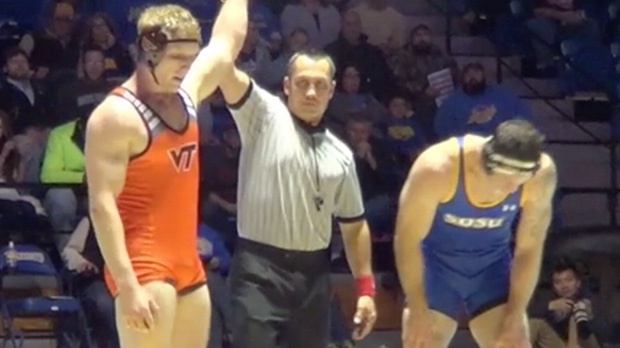By The Numbers: Virginia Tech vs South Dakota State
By The Numbers: Virginia Tech vs South Dakota State


Takedowns: Committed Attacks:
VT: 16 VT: 44
SDSU: 10 SDSU: 45
Takedowns and committed attacks work together and all successful takedowns are counted in the committed attacks. Virginia Tech converted at a higher rate, and it makes sense when you watch all of the matches.
SDSU controlled the action on the mat when they were victorious by large margins. This didn’t allow the Hokies to chase late in matches that they trailed. SDSU did fire off a lot of attacks when they trailed late in matches.
Reversals:
VT: 0
SDSU: 1
This continues to amaze me as I break more matches down. In 20 folkstyle bouts that we have looked at there have been two reversals. I will continue to preach about the reversal matching the value of the takedown if they choose to increase its point value.
Nearfall:
VT: 2 sets of 4
SDSU:3 sets of 4, 3 sets of 2
Bonus points make differences in dual meets and the four-point nearfall continues to impact individual match-ups significantly. We again saw a four-point nearfall scored from a four-count. I have a feeling this two-point swing from the old rules is going to show up in a significant match this year, and I like the change. Reward the wrestler scoring nearfall.
Out of Bounds:
VT: 6 Resulting In Stall Calls: 2
SDSU: 2 Resulting In Stall Calls: 0
From The Top/Bottom Position: 10
The breaks in action were plentiful. The confusing part about this stat is the lack of stall calls accompanying the out of bounds calls. There is so much gray area in the rules that it has to be confusing for the competitors and coaches. If they are dumbfounded, how do you think the fans in the bleachers feel?
The rules committee and officials need to get a handle on this before it plays a major role in an important bout. I don’t blame the official in this match because the rule isn’t written to make it clear. Watch these five clips and see if you can pick out which two instances that drew stall warnings? Did you pick out the situations that were considered action? If you were able to clearly pick them out, you have a better eye for this than I do at this point. The officials are in an impossible position. Please make it a clear step-out rule.
*Read below to find what clips were stalling and which ones were action.
Stall Calls:
VT: 6
SDSU: 1
You always see situational stalling calls. When a competitor protects a lead late in the match you will see the fist go up. This is where VT picked up most of their warnings. Total stall calls don’t seem to have a correlation to the winning dual team.
The two top clips of Solomon Chishko were called stalling. The middle clips of Chishko and the bottom clip of Haught was called action. Unintended consequences almost reared their head as Haught was called for stalling just seconds before going out of bounds. I thought it looked like a clear stall call for the boundary violations, but would that really be fair to call just after the initial warning?
Riding Time:
VT: 2
SDSU: 2
Riding time has been a solid indicator to the outcome of the match. It is very difficult to win a match while giving up riding time. In breaking down 20 bouts, 10 riding time points have been earned. All ten matches have been won by the wrestler earning the riding time point. Earning riding time in a loss happens, but not often.
I am sure everyone has an opinion on the new stalling rules. What is your remedy to clarify the rules? Form your opinion after watching the whole dual meet here.
Related Content
 Cohlton Schultz Is Confident Heading Into Olympic Trials
Cohlton Schultz Is Confident Heading Into Olympic TrialsApr 18, 2024
 Super 32 Champ Maddox Shaw Commits To Ohio State Wrestling Program
Super 32 Champ Maddox Shaw Commits To Ohio State Wrestling ProgramApr 18, 2024
 The NCAA Women's Freestyle Transfer Portal Is Open
The NCAA Women's Freestyle Transfer Portal Is OpenApr 17, 2024
 2024 Olympic Wrestling Trials Preview: Women's Freestyle 68 kg
2024 Olympic Wrestling Trials Preview: Women's Freestyle 68 kgApr 16, 2024
 2024 Olympic Wrestling Trials Preview: Women's Freestyle 76 kg
2024 Olympic Wrestling Trials Preview: Women's Freestyle 76 kgApr 16, 2024
 2024 Olympic Wrestling Trials Preview: Women's Freestyle 62 kg
2024 Olympic Wrestling Trials Preview: Women's Freestyle 62 kgApr 16, 2024
 Last Week In Recruiting: April 8-14
Last Week In Recruiting: April 8-14Apr 16, 2024
 4x All-American Samantha Miller Transfers To McKendree
4x All-American Samantha Miller Transfers To McKendreeApr 16, 2024
 2024 Olympic Wrestling Trials Preview: Women's Freestyle 57 kg
2024 Olympic Wrestling Trials Preview: Women's Freestyle 57 kgApr 15, 2024